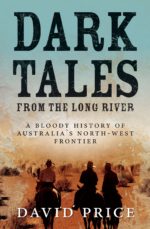Carnarvon-born writer David Price encourages us to accept a more complete account of the Gascoyne’s history

David Price says when we hold strong views about a subject, we often do not like to listen to contrary ones. He says, ‘In fact, we live in a time when we are able to exclusively access – mainly online – only the information and opinions that suit our own view of the world. In Australia, many of us have trouble accepting the full truth of our history, especially when it involves legalised theft, racism, murder and exploitation or profound miscarriages of justice.’
In his new book, Dark Tales from the Long River: A Bloody History of Australia’s North-West Frontier, Price says he hopes we can all come to a greater understanding of how Australia’s laws have often served to maintain order rather than to secure justice.
What inspired you to write this book?
I grew up in the town of Carnarvon and, although I went to school there for 12 years, the only thing I learned about Aboriginal people was that they were hunters and gatherers, and that Albert Namatjira was a famous painter. This did not help me understand the Aboriginal people with whom I went to school, or their parents. It didn’t explain why some Aboriginal people lived on a government reserve at the outskirts of town or why some children lived on a Christian mission far away from their parents. At the same time, there was nothing in my town to remind me that Asian people had once been part of the town’s early history. Only a small, separate part of the cemetery gave any clue to their existence. As I grew older, I came to realise that most communities – and their teachers – have only a narrow knowledge of local history, particularly when it relates to cruelty or unfairness. It seemed to me that all of Australia had adopted a wilful amnesia, had chosen to forget what was uncomfortable about our history since colonisation. So I decided to write these stories because I thought it was a simple way to get people to engage with our past. Sometimes we find it easier to read a story rather than to listen to a lecture. I have tried to leave my voice out of the stories for that reason. I want the reader to come to their own understanding of the past, and to reach their own conclusions.
Do you have any personal connection to any of the people or places in the book?
One of the stories in this book involves a legendary pearl that was found in Broome in 1905. Stories about the pearl, which was stolen and led to the deaths of four people, have abounded in Broome for all the many decades since. While many myths have grown up around the pearl, I have avoided these because the truth is just as interesting. My great-grandfather, John Travers, was the co-owner of the lugger, Cleopatra, that found the infamous pearl. When he and my great-grandmother, Georgina, escaped the turmoil that followed the pearl’s disappearance, they came to Carnarvon with their baby daughter, Sheila, my grandmother. Within a couple of months, however, John Travers disappeared off the Carnarvon jetty and was never seen again. Georgina was from Scotland and now she was a single mother in a distant and hostile land, stranded in an outback town far from anywhere. Even so, she set up her own successful business and became a well-known and admired member of community still struggling to establish itself on the edge of the Indian Ocean. At the same time, Georgina raised Sheila single-handedly and provided for her education. She never remarried. Georgina was a remarkable person but, in many ways, she was also a pioneer of today’s modern woman. Her story reminds us of the enormous, often unwritten, contribution that women made to the growth of the Australia we know today.
How did you research the amount of detail you’ve included, which makes these stories feel so real?
Most of my research began in Trove, a searchable online government repository of all the newspapers published since the beginning of Australia’s colonisation. I then supplemented the news stories with research from Hansard, the record of parliamentary debates and proceedings, as well as historical references and court records. I have focused on newspapers because the language they used gives us a powerful insight into prevailing attitudes and beliefs about law, order, punishment, migration and Aboriginal rights. It is telling and confronting for the modern reader to see, for example, racist language routinely appearing in the newspapers of the time.
Dark Tales from the Long River by David Price is available in all good bookstores and online.



